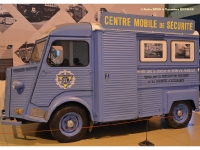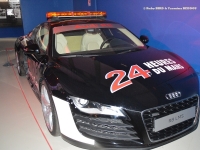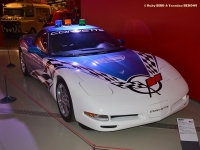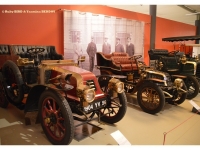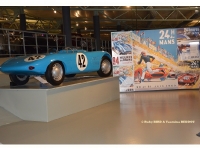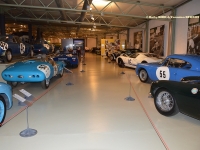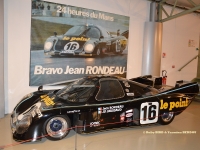Automobiles
Exceptional Visit of the MUSEUM of the 24 HOURS OF LE MANS CIRCUIT
Run by WEST CLUB AUTOMOBILE
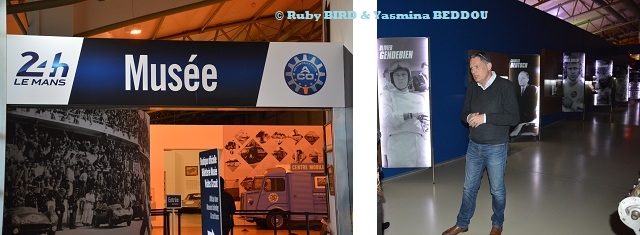
Nicolas PELLETIER Heritage Department Guide (ACO) (Source: © Ruby BIRD & Yasmina BEDDOU)
USPA NEWS -
The 24 Hours of Le Mans has over the years inspired imitating races all over the globe, popularizing the 24-hour format. The American Le Mans Series and Europe's Le Mans Series of multi-event sports car championships were spun off from 24 Hours of Le Mans regulations...
The 24 Hours of Le Mans has over the years inspired imitating races all over the globe, popularizing the 24-hour format. The American Le Mans Series and Europe's Le Mans Series of multi-event sports car championships were spun off from 24 Hours of Le Mans regulations. So, The 24 Hours of Le Mans is the world's oldest active sports car race in endurance racing, held annually since 1923 near the town of Le Mans, France. It is one of the most prestigious automobile races in the world and is often called the 'Grand Prix of Endurance and Efficiency'. The event represents one leg of the Triple Crown of Motorsport; other events being the Indianapolis 500, and the Monaco Grand Prix.
Instead of focusing on the ability of a car company to build the fastest machines, the 24 Hours of Le Mans would instead concentrate on the ability of manufacturers to build sporty yet reliable cars. This encouraged innovation in producing reliable and fuel-efficient vehicles, because endurance racing requires cars that last and spend as little time in the pits as possible.
The race is held in June, leading at times to very hot conditions for drivers, particularly in closed vehicles with poor ventilation; rain is commonly seen. The race begins in mid-afternoon and finishes the following day at the same hour the race started the previous day.
The race is held in June, leading at times to very hot conditions for drivers, particularly in closed vehicles with poor ventilation; rain is commonly seen. The race begins in mid-afternoon and finishes the following day at the same hour the race started the previous day.
Originally, the race showcased cars as they were sold to the general public, then called 'Sports Cars', in contrast with the specialized racing cars used in Grand Prix motor racing. Over time, the competing vehicles evolved away from their publicly available road car roots, and today the race is made of two overall classes : prototypes, and Grand Touring cars. There are various long-standing traditions at Le Mans, including the waving of the French tricolor to start the race. Le Mans was the venue for the first televised instance of a winning driver celebrating by spraying champagne instead of drinking it.
The first race was held on 26 and 27 May 1923 and has since been run annually in June with exceptions in 1956, when the race was held in July, and 1968, when it was held in September due to nationwide political turmoil in May. The race has been cancelled ten times, in 1936 (a labour strike during the Great Depression) and between 1940 and 1948 (World War II). The circuit on which the 24 Hours of Le Mans is run is named the Circuit de la Sarthe, after the department that Le Mans is within. It consists of both permanent track and public roads that are temporarily closed for the race. Since 1923, the track has been extensively modified, mostly for safety reasons.
The 24 Hours of Le Mans was first run on 26 and 27 May 1923, through public roads around Le Mans. The early races were dominated by French, British, and Italian drivers, teams, and cars, with Bugatti, Bentley, and Alfa Romeo being the top brands. Innovations in car design began appearing at the track in the late 1930s, with Bugatti and Alfa Romeo running highly aerodynamic bodywork in order to run down the Mulsanne Straight at faster speeds. The Porsche 917, 935, and 936 were dominant throughout the decade 1970-1980.
This decade (1970-1980) is also remembered for strong performances from many privateer constructors, with two scoring the only victories for a privateer, in the decade. John Wyer's Mirage won in 1975, while Jean Rondeau's self-titled chassis took 1980. The rest of the 1980s was known for the dominance by Porsche under the new Group C race car formula that encouraged fuel efficiency. In 1992 and 1993, Peugeot dominated the race with its Peugeot 905 as the Group C formula and World Sportscar Championship were fading in participation....
The 2010 running reaffirmed the race as a test of endurance and reliability. The 2011 and 2012 races were marred by a series of accidents. In 2011, in the first hour, the Audi driven by Allan McNish crashed heavily, barrel rolling into a tire wall shortly after the Dunlop Bridge. At night, the defending race-winning Audi driven by Mike Rockenfeller crashed in similar fashion between the Mulsanne and Indianapolis corners. Neither driver was injured, nor were any spectators. In 2011, the race became the premier round of the Intercontinental Le Mans Cup, an attempt to make a world championship for endurance racing again.
In 2012, the race became the centerpiece of the FIA World Endurance Championship, the successor to the ILMC. The 2012 event was the first time the race was won by a hybrid electric vehicle, which was the Audi R18 e-tron quattro. After Audi's dominance of the event in the early 2000s, Toyota has fielded competitive cars since 2012, Porsche returned to Le Mans in 2014 with a new factory LMP1 program,and Nissan returned to run an LMP1 program in 2015....As of 2016, Porsche remains the most successful manufacturer with a record 18 overall victories, including a record seven in a row.
Three drivers stand apart for their number of victories. Initially Jacky Ickx held the record at six, scoring victories between 1969 and 1982, earning him an honorary citizenship to the town of Le Mans. His frequent racing-partner, Derek Bell, trailing by a single win, with five. However, Dane Tom Kristensen has beaten this record with nine wins between 1997 and 2013, including six in a row. Three-time winner Woolf Barnato (1928 to 1930) and American racing legend A. J. Foyt (1967) are the only drivers to have won every Le Mans in which they participated
Henri Pescarolo won the race four times, and holds the record for the most Le Mans appearances at 33. Japan's Yojiro Terada was active as a driver until 2008, and holds the record for the most Le Mans starts without an overall win. Graham Hill is the only driver to win the so-called Triple Crown of Motorsport, winning the Indianapolis 500 (1966), Monaco Grand Prix (1963, 1964, 1965, 1968, 1969), and the 24 Hours of Le Mans (1972).
The race became the center of a major motion picture in 1971 when Steve McQueen released his simply titled 'Le Mans', starring McQueen as Michael Delaney, a driver in the 1970 event for the Gulf Porsche team. Likened to other motorsports films such as Grand Prix for Formula One racing and Winning for the Indianapolis 500, Le Mans is the best known film to center on sports car racing. 'Michel Valliant' was a 2003 French movie about a French comic book motorsports hero that featured events from the 2002 race although it was not explicitly about Le Mans...
Source : Visit at the 24 Hours of Le Mans Museum on March 1, 2017
Ruby BIRD
http://www.portfolio.uspa24.com/
Yasmina BEDDOU
http://www.yasmina-beddou.uspa24.com/
Source : Visit at the 24 Hours of Le Mans Museum on March 1, 2017
Ruby BIRD
http://www.portfolio.uspa24.com/
Yasmina BEDDOU
http://www.yasmina-beddou.uspa24.com/
Ruby Bird Yasmina Beddou West Club Automobile Museum Motorsports Lovers Races Of Le Mans The 24 Hours Of Le Mans Endurance Racing Triple Crown Of Motorsport Indianapolis 500 The Monaco Grand Prix
Liability for this article lies with the author, who also holds the copyright. Editorial content from USPA may be quoted on other websites as long as the quote comprises no more than 5% of the entire text, is marked as such and the source is named (via hyperlink).



